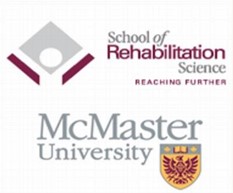- Home
- MURAnews
- Previous issues
- Spring 2017 - present
- Winter 2023
MURAnews Winter 2023
MURAnews Winter 2023 issue in PDF format / in accessible PDF format
In this issue:
I hope that everyone had a joyous and happy holiday season. At the start of the new year we look to new beginnings for ourselves as individuals and for MURA as an organization. In 2022 we had one in-person event, the very well received late-October visit to the McMaster planetarium. That event was suggested by a member, so if you have a good idea for a trip, event, or speaker, please do send it to us. Many people were still very reluctant to gather in large groups, so our other 2022 events remained virtual. We do hope that 2023 will allow us to return to meeting together in person. We are planning some events to make up for the past three years, including a spring social, a meet and greet for recent retirees, and a return to our popular December holiday lunch. Our Annual General Meeting will remain virtual (see page 3), as that provides for as many members as possible to attend. Watch for notices of these events in this and upcoming MURAnews issues. Susan Birnie
News from MURA
Call for NominationsMURA is a volunteer-based organization whose mandate is to facilitate a continuing spirit of unity and connection among retirees and former colleagues, represent the interests of members in matters relating to their accrued benefits, contribute to and support the University, and foster an understanding of MURA’s functions among employees nearing retirement. See Article 2 of the MURA Constitution. The duly constituted MURA Nominating Committee is now receiving input for the nomination of Council members for the three-year term starting in June 2023, as well as for President and Vice President for a one-year term. The list of candidates will be presented by the Nominating Committee at the March meeting of Council. Council representatives: John Horsman, Kathy Overholt Recent Passingscompiled by Kathy Overholt
Molly Naylor, Office of the Registrar (Admissions), January 26, 2023 Dennis Perry, Pathology, December 9, 2022 Welcome New Retireescompiled by Kathy Overholt Lori Baker, University Secretariat From the MURA ArchivesA Look at Pension IncreasesBy Mary Johnston With the current high prices of food and other necessities, many pensioners are feeling the pinch. News (see Pension Plan Updates in this newsletter) that McMaster retirees who are members of either the Salaried Pension Plan or the Hourly Pension Plan did not get any increase in their pensions for 2023 may only add to those worries. Looking back through the MURA archives, the first mention of an increase to McMaster pensions occurred in 1991 when the minutes of MURA’s Annual General Meeting noted that “The Pension Trust Committee has recommended an increase of 4.8% to retirees on July 1, 1991”. I found evidence that annual increases have been granted 23 times since then, the most recent being 1.45% in 2022. Only twice did these increases reach the heady heights of 1991: 5.61% in 1992 and 6.39% in 2015. Members of the Salaried Pension Plan received no increase in 2005, 2010, 2011, 2012, 2013 and 2023. The recent history of the Hourly Pension Plan is even more discouraging. In addition to the years listed in the previous sentence, members of the Hourly Plan had no pension increase in 2006, 2007, 2014 and 2021. Calculation of annual increases is based on three parameters: the average increase in the Consumer Price Index (CPI) for the last year, the average rate of return on the investments in the pension fund (averaged over the last five years), and criteria specified in the text of each pension plan setting out an upper limit for the investment-return figure used in the calculation. See Pension Plan Updates in this newsletter for a complete explanation of how increases are calculated and the exact figures for 2023. The CPI is used as an indicator of increases in cost of living. Statistics Canada calculates the CPI using the costs of a wide range of goods and services in eight categories: (i) food; (ii) shelter; (iii) household operations, furnishings, and equipment; (iv) clothing and footwear; (v) transportation; (vi) health and personal care; (vii) recreation, education and reading; and (viii) alcoholic beverages, tobacco products and recreational cannabis. The CPI is not a perfect measure as can be illustrated by a statement in the minutes of MURA’s AGM in 1995: “Although the underlying inflation rate is about 2.5%, the actual increase in the CPI for 1994 was only 0.23% due to the cut in the tax on cigarettes; this 0.23% is the amount which retirees will get as a pension increase July 1st.” That said, Statistics Canada does revise how the CPI is calculated from time to time with the aim of aligning the CPI with consumer purchasing patterns. If you would like to find out more about the ups and downs of the CPI over the years, visit the Statistics Canada website. [For those of you who like exploring data: Slide the bar under the graph to the left to show information going back as far as 1914. Hover your cursor over the graph and move the dotted red line across the graph to pop up monthly increases in CPI in the ‘Legend’ box to the left of the graph] Given this glimpse into our archives, you may be asking yourself “Is my McMaster pension keeping up with inflation?” For an in-depth analysis of this question, take a look at two articles in the Winter 2020 issue of MURAnews: McMaster pension plans: how have they done over the past 10 Years? and Are our pensions keeping up with inflation? Spoiler alert: The short answer is “No”. Retirees in the NewsBy Marcia MacAulay Gary Schrobilgen, retiree and Emeritus Professor in the Department of Chemistry & Chemical Biology, was awarded the European Academy of Sciences’ (EurASc) prestigious Blaise Pascal Medal in Chemistry (2022) at a ceremony in Brussels, Belgium on October 25th. The Medal was awarded for Gary’s contributions to the advances of science in the field of chemistry. Established in 2003 and named after the 17th century French mathematician and philosopher, the Blaise Pascal Medal is awarded to outstanding scientists around the world who have demonstrated a personal contribution to science and technology and the promotion of excellence in research and education. A fellow of the Royal Society of Canada, Gary’s research field, fluorine chemistry, has numerous applications in nuclear power generation, photovoltaic and semiconductor materials, refrigerants, advanced rocket propellants and microelectronics. He has also applied his research to practical problems around medical imaging, the uranium re-enrichment cycle and high-energy density materials. View the Brighter World article: Professor emeritus receives prestigious international award for contributions to field of chemistry. Graham Petrie, retiree and Emeritus Professor in the School of the Arts, and internationally renowned Hamilton Fellow in film and literature, was recently honoured with a lifetime achievement award from the Toronto Film Society (TFS). Graham’s receipt of this first Petrie Award, named in his honour, is the start of what will be a tradition at TFS. It is fitting recognition for a man who has been a powerful force for international awareness and appreciation of film in Canada and beyond for almost 60 years. He joined the Society in 1965, shortly after moving to Canada from England to take up a faculty position at McMaster University. By 1968 he had introduced film classes as part of the curriculum at McMaster. During his career at McMaster, he taught both English and film. View the Canada Today article: Film scholar from Hamilton receives the first Petrie Award. |
Contacting Human ResourcesMail Gilmour Hall 304, McMaster University 1280 Main Street West, Hamilton, ON L8S 4L8 Phone 905-525-9140, extension 22247 Email hr.mcmaster@mcmaster.ca Website https://hr.mcmaster.ca/retirees/ |
Free Online Access to Newspapers and Magazines Through Hamilton Public Library
By Nora Gaskin
Did you know that your Hamilton Public Library (HPL) card can give you free online access to hundreds of newspapers and magazines in over 60 languages?
Newspapers include not only the Hamilton Spectator (the Spec), but international titles, from the New York Times, the Guardian, and the Wall Street Journal to Pravda, Corriere della Sera and the Times of India. The number and variety of magazines available is also impressive, with The Economist, the New Yorker, National Geographic and New Scientist rubbing shoulders with the Walrus, Maclean’s, Rolling Stone, Reader’s Digest, PC World, Vogue, Popular Mechanics, Prevention, Bon Appetit and many more.All that is needed to access this online wealth of content is the barcode on the back of your HPL library card along with the PIN you use to access your library account online. We recommend you type the barcode once and save it to a text file or email so you can copy and paste it as needed, since a 13-digit number is neither fun nor easy to type accurately!
Note: Most other public libraries offer the same or similar resources through their web sites.HPL Online Newspapers and Magazines Step-by-step Guide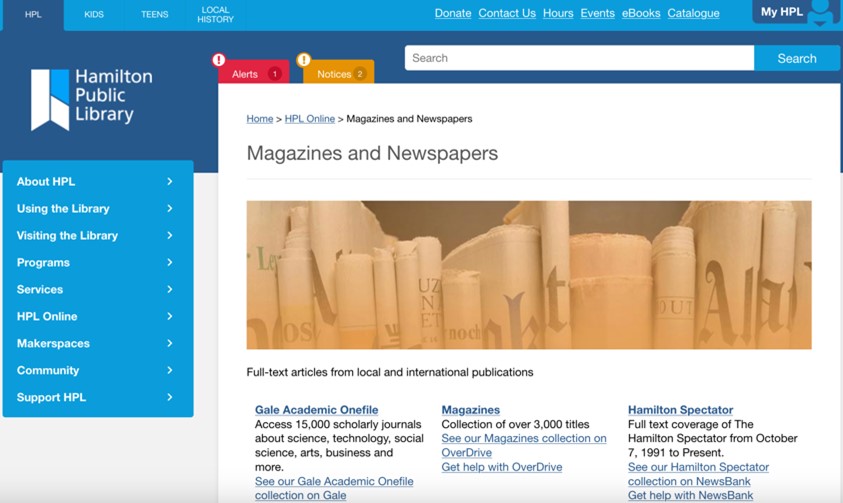
- Go to the Hamilton Public Library (HPL) website
- Click on HPL Online
3. Select Magazines and Newspapers. From here you have a choice of seven online resources, each offering a different suite of publications, notably:
- On a laptop or desktop, it’s in the list on the left of the screen
- On a tablet or phone, it’s in the dropdown menu (the three parallel lines in the upper right corner of the screen)
- Gale Academic Onefile includes 15,000 scholarly journals about science, technology, social science, arts, business and more.
- Magazines on OverDrive is a collection of over 3,000 magazines. Individual issues can be borrowed for a period of 1, 2 or 3 weeks, similar to borrowing books.
- Hamilton Spectator through NewsBank has full text coverage of the Spec from October 7, 1991 to present.
- PressReader Newspapers and Magazines includes the Spec from 2012 to present, as well as a large variety of other newspapers and magazines.
The other three resources offer access to the New York Times, the Globe and Mail Historical file from 1848 to 2018, and a variety of world news sources.
MURA had a question recently about how to get free online access to the Hamilton Spectator, so we will use it as an example of how to proceed from here, and what you can expect when you get there.Hamilton Spectator online access through NewsBank
This interface lets you browse issue by issue or search for topics, names, or keywords. The articles appear on the screen in plain black text on a white background and are quite easy to read. Photographs and graphics are not included. There is an option to have articles read aloud by a text-to-speech service by clicking the Read News Document button at the top of each article.
- From the Magazines and Newspapers page, click Hamilton Spectator
- In the NewsBank window, type (or paste) your library card bar code, with no spaces, and click Log in.
- The Hamilton Spectator Collection is the last of the Search Shortcuts bullet points on the NewsBank starting page. Once you click that, you have two versions of the paper to choose from:
- the regular edition, 1991 – current
- the web edition, 2013 – current
- A little investigation showed that more articles from each issue are included in the regular edition, so choose it for fuller coverage.
- There are a few oddities, though – the articles are listed by their headlines, grouped under general headings such as Business, Canada/World, Editorial, etc. In the issue I looked at, Ellie Tesher’s advice column was listed under the heading “Weather”!
Hamilton Spectator online access through PressReader
With PressReader you have the option of seeing each issue of the newspaper in page view, which provides full page images of the newspaper, including photos, ads, and everything you would see if you had the physical newspaper in your hands. There are more viewing options on a desktop, tablet, or laptop than on a phone. These include the option to read the articles in an easier-to-read text view, which includes full colour photos. You can also limit your results to articles by individual reporters’ names, jump to a particular section of the newspaper, or search by topic. There is also an option to have articles read aloud by a text-to-speech service by clicking the Listen button at the end of each article.
There are more viewing options on a desktop, tablet, or laptop than on a phone. These include the option to read the articles in an easier-to-read text view, which includes full colour photos. You can also limit your results to articles by individual reporters’ names, jump to a particular section of the newspaper, or search by topic. There is also an option to have articles read aloud by a text-to-speech service by clicking the Listen button at the end of each article.
- From the Magazines and Newspapers page, click PressReader Newspapers and Magazines
- In the PressReader window, click Sign In
- In the next window, click Library or Group, and select Hamilton Public Library from the dropdown list. Alternatively, click the magnifying glass search icon and search for Hamilton.
- Input the barcode from your library card, with no spaces, and your library PIN, agree to the conditions, and click Log In.
- The “Featured” listing of newspapers at the top of the screen includes the Hamilton Spectator, but you may have to click the right-arrow, or scroll right to get to it. Alternatively, click the magnifying glass search icon at the top of the page, and search for Hamilton Spectator. Click on the image of the Spec to see the latest issue at the top of the page; previous issues are shown below.
If you’re on a mobile device, you can use the PressReader app for a more user-friendly interface, but first you will have to create a free PressReader account.
HPL PressReader help page: Getting Started with PressReaderMac Optimal Aging Portal E-Learning Tutorials
By John Horsman
In this mid-winter look at the McMaster University Optimal Aging Portal (MOAP), I am focusing on the e-learning tutorials that cover various topics on health and well-being. There are currently six lessons on offer. The format for the lessons is similar, with each hosted and narrated by McMaster University professor Dr. Anthony Levinson. Listed here are the six lessons and the approximate run time for each although you may pause, restart, or skip within each lesson to suit your needs..
1. Anxiety Disorders
Do you know the signs and symptoms of anxiety disorders and how they are diagnosed and treated? Learn more about what anxiety is, the different types of disorders, and what questions you should ask your healthcare provider if you are concerned about your mental health. (35 minutes)
2. Osteoarthritis and Exercise
Discover how to best manage osteoarthritis of the hip and knee to reduce your symptoms and improve your mobility. Learn more about a self-management plan that includes therapeutic exercise, physical activity, and weight management. (15 minutes)
3. Promoting Brain Health
Enhance or extend your physical mobility and social activity in the future by actively promoting brain health and reducing your risk of developing dementia. Learn more about how lifestyle choices, blood vessel health and other health conditions and drug side effects can impact your cognition. (30 minutes)
4. Walking Speed - is it a new vital sign?
Like your heart rate, blood pressure, body temperature and rate of breathing, walking speed may be an important new vital sign. Learn more about what walking speed is, how it changes as we age, how to measure it, and what steps you can take to increase it to improve your mobility and overall health. (15 minutes)
5. Social Isolation: are you at risk?
The risk factors for social isolation are many and varied. It can have a significant impact on a person’s health and well-being. Learn more about the risk factors and how optimizing your mobility, expanding your social network, and proactively addressing specific health concerns can reduce your risk. (20 minutes)
6. Changing Gears: Making a plan to retire from driving
Retiring from driving, also known as driving cessation, either voluntarily or otherwise, can profoundly impact a person’s life. Learn more about the warning signs that may indicate unsafe driving habits, age-related health conditions and other factors that can affect your ability to drive safely; and learn about the importance of planning for a time when you can no longer drive. (15 minutes)
As noted above, the overall format is similar for each lesson so let’s delve more deeply into one of these e-lessons to look and hear what it says about Osteoarthritis (OA) and Exercise.
Open your favourite web browser and go to the McMaster Optimal Aging Portal (MOAP). Click on “E-Learning” on the menu bar at the top of the page, or there may be a dropdown menu (three parallel lines in the upper right corner of the screen) where you can select ‘E-learning’. Scroll to the Osteoporosis and Exercise option and click the “Start Lesson” button. The program loads automatically (watch the red line creep across the bottom of your computer screen). Make sure the volume on your computer is set to a comfortable level and then click on the “NEXT” button in the lower right of your screen.
(NOTE: you can pause and resume by using the > or || icons at the left end of the thin red line and go back to a previous page or skip ahead by using <PREV and NEXT> at the right end of the line.)
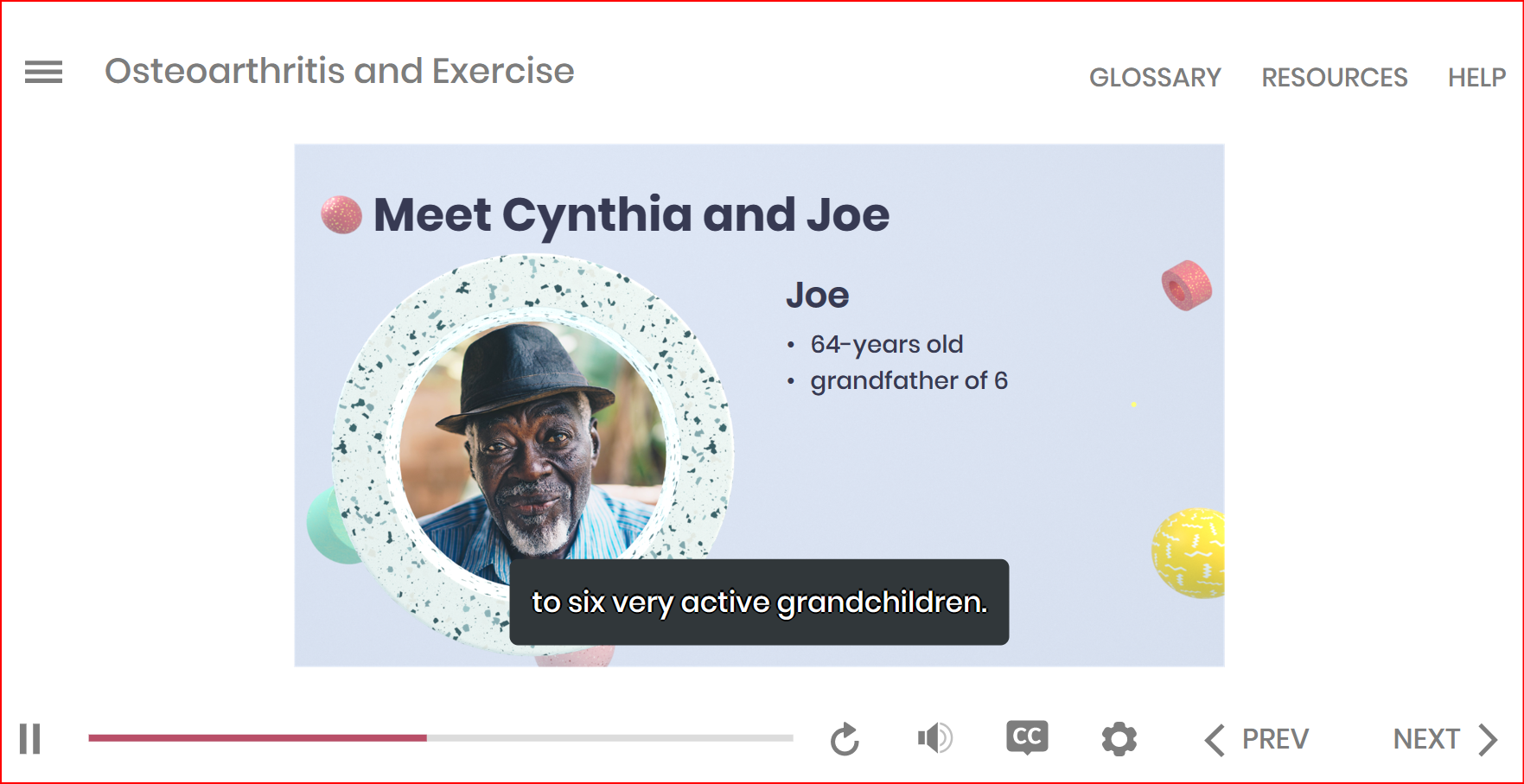
Dr. Levinson introduces himself and begins with a quiz about the Facts and Myths of OA. Hint: The answers are all the same and do not begin with the letter “T”.
Two scenarios are presented in this lesson. First we meet Cynthia, a 55 year-old, recently retired teacher. Over the past few years she is having difficulty with stiffness and pain in her hips and knees making it difficult to manage stairs and other mobility issues. Next we meet Joe, a 64 year-old grandfather of six. Joe was diagnosed almost 10 years ago with osteoarthritis in his right knee. Although he manages with medication and trying to stay active, he and Cynthia wonder what else they can do to ease pain and help with their mobility. When the introductions to Cynthia and Joe end, click “NEXT” once again to load the next screen.
Following the quiz, Dr. Levinson goes on to outline what can be done to help sufferers with OA including self-management, therapeutic exercises, and neuromuscular training. Each item is expanded upon in subsequent pages with facts and figures, hints and tips, along with examples and suggestions on how to manage your arthritis pain. For example, let us look at the “Weight Management” portion of the lesson.
Weight Management (remember the quiz? - being overweight does not cause OA). But
losing weight will likely improve joint pain symptoms. Transitional movement, moving from one situation to another, such as from sitting to standing up or from walking on level ground to climbing stairs, is strongly affected by weight loss. A 10-pound (4.5 kg) weight loss removes 60 pounds of force off a knee joint. If you have OA and are overweight you should set a goal to lose 6-10% of your body weight. For example, if you weigh on the order of 200 lbs (about 98 kg), you should set a goal to lose 12-20 lbs (about 6-10 kg). Depending on how overweight a person is, research shows that improvement continues with increased weight loss even upwards of 10-20% or more. When weight loss is combined with exercise, the benefits to symptom management are doubled. A successful weight loss plan means changes to your nutrition. Consider meeting with a dietician to find a food/meal plan tailored for you.
The lesson then goes on to look at other aspects of how to manage your OA, including physical activity and exercising.
A strong word of caution, if any sort of regular exercise has not been on your daily or even weekly agenda it is recommended that you see your doctor or a physiotherapist with a good knowledge of OA before embarking on any new program of exercise.
Once the lesson is completed it cycles back to Cynthia and Joe to see what course of action they chose for themselves. But I won’t spoil the ending.
Each of the lessons in the series follow a similar format and navigation structure. For example:
- Anxiety Disorders: What is anxiety? What causes anxiety disorders? What are the different types? How are they diagnosed and treated? What should you ask your healthcare provider?
- Promoting Brain Health: Outlined are six factors to promote brain health including: physical activity and weight management; diet and nutrition; blood vessel health; smoking and alcohol; brain and social activity; other health conditions, and drug side-effects.
Please note the disclaimer on these lessons. They are for educational purposes only and not intended to be a substitute for professional medical advice, diagnosis, or treatment.
If you are interested and OA is a problem for you or a loved one, or if you would like to explore one of the other lessons in this series, check out the MOAP website.
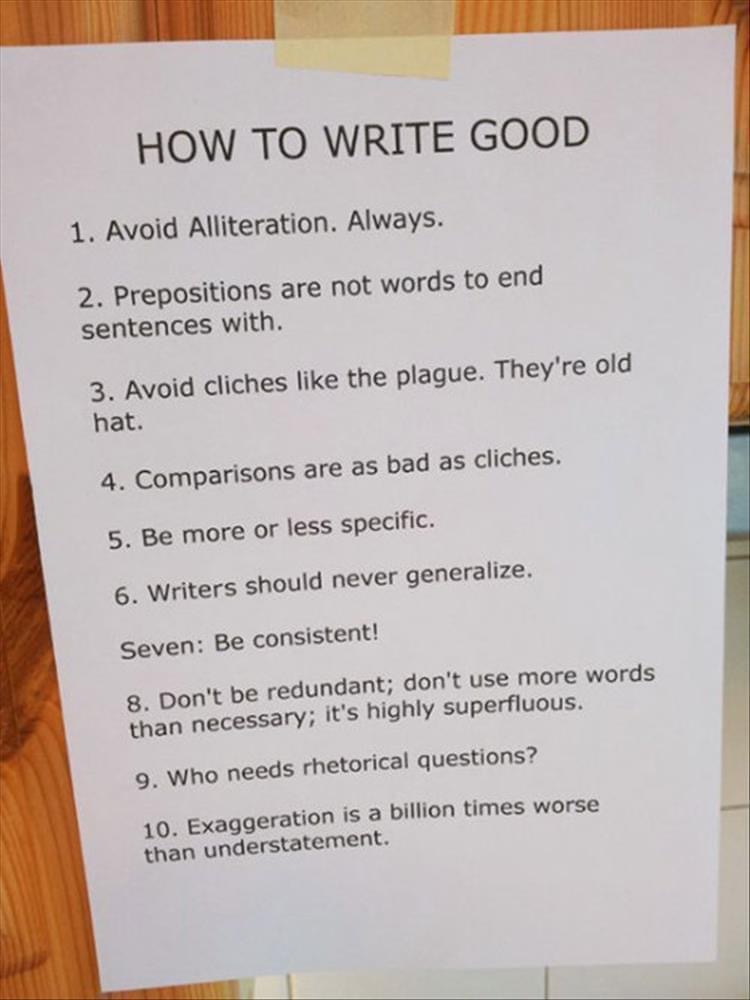
courtesy of Meanwhile in Canada
Parking on Campus
Permit Expiry Renewal Reminder
Retiree parking permits are issued on a 12-month basis and must be renewed annually. Renew prior to your expiry date by email, phone or by postal mail. Your transponder number is on the front of your transponder. If you have questions or have not made a note of your expiry date, please contact McMaster Parking Services by email at parking@mcmaster.ca or at 905-525-9140, x24232.
Note that central-campus parking (with a transponder) is available to McMaster retirees as follows:
A note to retirees without parking transponders
- May to August each year:
- Access to lots B, C, D, H, I, K, N, P and Underground Stadium at all times.
- September to April each year:
- Access to Lots B, C, D and I after 12:30 pm on weekdays, and at all times on weekends and holidays,
- Access to Lots H, K, N, P and Underground Stadium at all times on weekdays, weekends and holidays.
Free on campus parking is available to all retirees. To take advantage of this perk, and to view retiree parking access, go to the McMaster Parking Services web page. Due to COVID-19, the Parking Office is accepting permit applications by email only. For further information, please contact Parking Services.
What's Happening at Mac
New Construction
New Hub for Student Life and Braley Gym Expansion
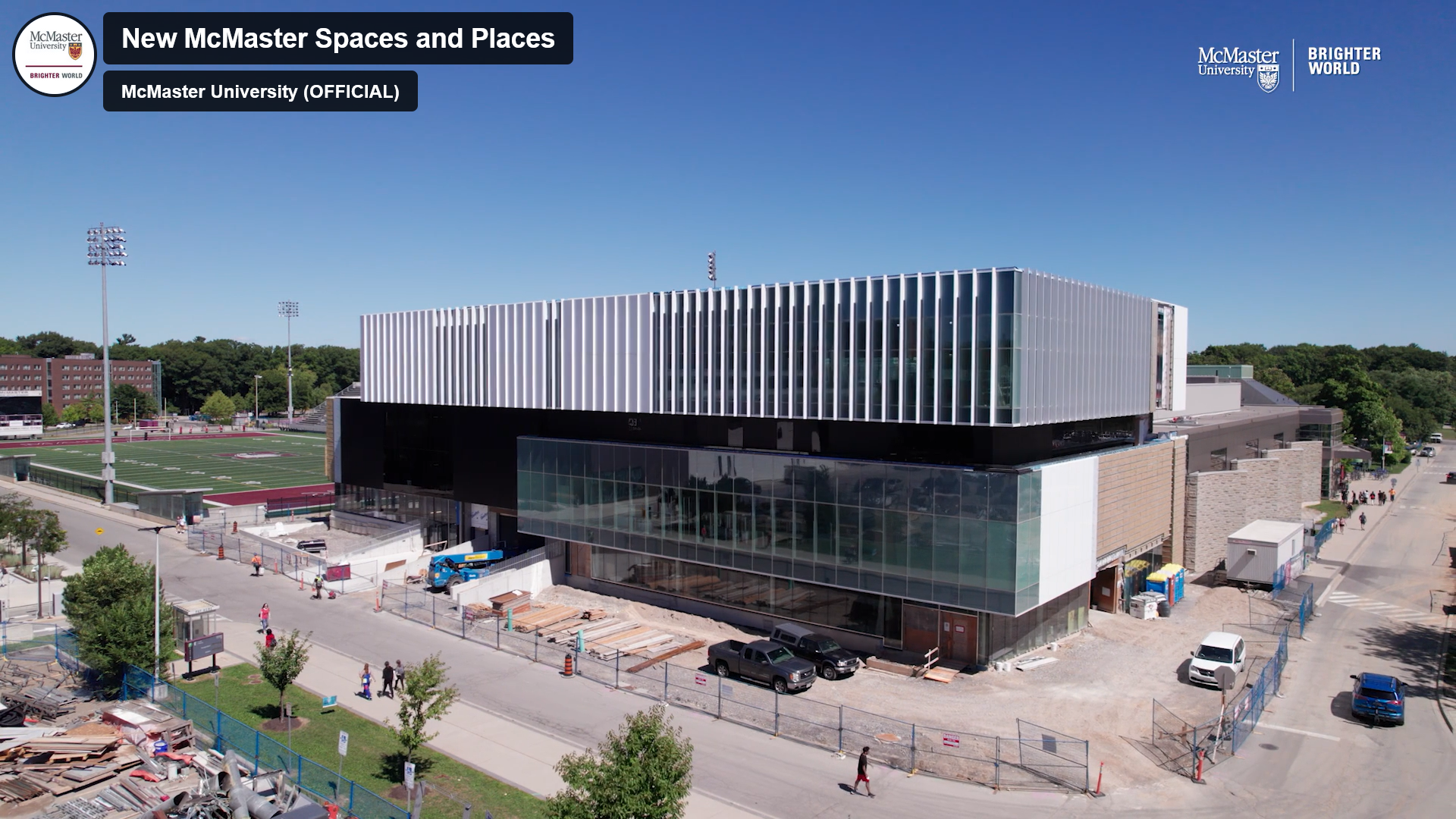 Construction is underway for a new hub of student life on campus that will boast four floors of multi-purpose lounge, study, and event spaces for students. The Hub will include a multi-faith prayer room, a peer support area, the campus food bank and more. It will be located adjacent to the David Braley Athletic Centre.
Construction is underway for a new hub of student life on campus that will boast four floors of multi-purpose lounge, study, and event spaces for students. The Hub will include a multi-faith prayer room, a peer support area, the campus food bank and more. It will be located adjacent to the David Braley Athletic Centre.An expansion of the Pulse Fitness Centre offering new fitness and weight training facilities, along with a women’s-only fitness area, opened in December. A climbing wall and additional fitness areas will be available later in the year.
This project is a partnership between the McMaster Students Union, Athletics and Recreation and the university. Transforming spaces and places to create a Brighter World – Daily News
McMaster University’s new greenhouse is being built in front of the Life Sciences Building.
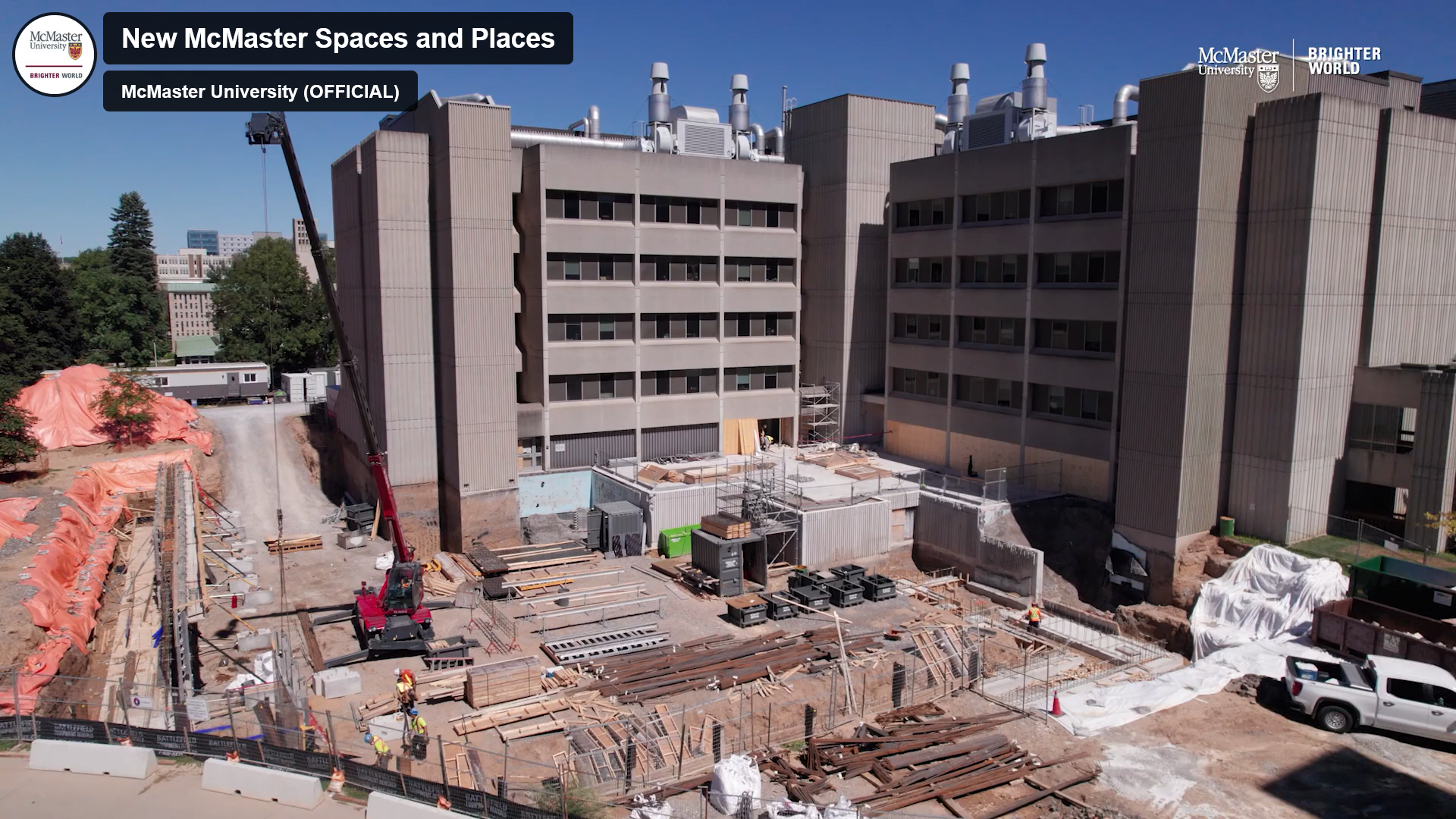 This greenhouse will be the first building on campus that is fully heated and cooled by a geothermal system. Sustainable energy sources are part of McMaster’s Net Zero Carbon Roadmap and Sustainability Strategy. The Department of Biology researchers will use the new space to study plant life at a cellular level.
This greenhouse will be the first building on campus that is fully heated and cooled by a geothermal system. Sustainable energy sources are part of McMaster’s Net Zero Carbon Roadmap and Sustainability Strategy. The Department of Biology researchers will use the new space to study plant life at a cellular level.The Life Sciences Building is also being upgraded to be more open and to make space for collaboration. Renovations will include accessible, gender-neutral washrooms. Transforming spaces and places to create a Brighter World – Daily News
 A 30-storey residence, McMaster’s first residence designed specifically for graduate students, is under construction on the south-west corner of Bay and King Streets, adding to the vibrancy of downtown Hamilton.
A 30-storey residence, McMaster’s first residence designed specifically for graduate students, is under construction on the south-west corner of Bay and King Streets, adding to the vibrancy of downtown Hamilton.Opening later this year, the 10 Bay Graduate Residence will feature a fitness centre, music room, movie theatre, green roofs, lounge areas, and event spaces with communal kitchens. When it opens, it will be operated by McMaster’s Housing and Conference Services and have in-building Residence Life support.
The complex is being developed via a public-private partnership that includes the university and Knightstone Capital Management, a company that specializes in developing academic residences. Transforming spaces and places to create a Brighter World – Daily News[earlier versions contained an incorrect building location]
New Undergrad Residence Named After Lincoln Alexander
McMaster University is naming its new undergraduate student residence after the late Lincoln Alexander, former Lieutenant Governor of Ontario and a McMaster graduate who was an advocate for education and an activist for racial equity in Canada.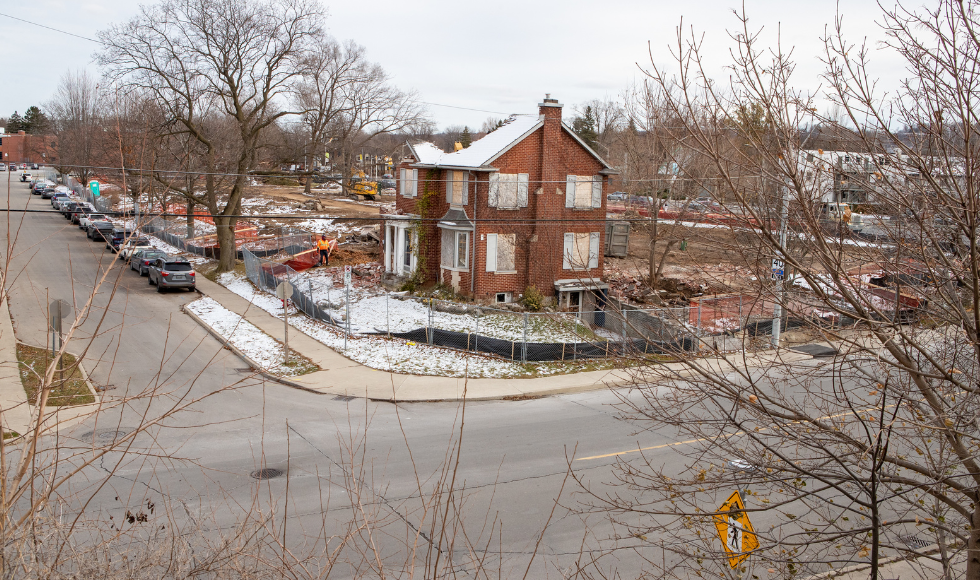 The new residence complex will be built in the block east of the University bounded by Main Street West and Traymore Avenue, between Dalewood and Forsyth. The houses in that block have been demolished. [see photo]
The new residence complex will be built in the block east of the University bounded by Main Street West and Traymore Avenue, between Dalewood and Forsyth. The houses in that block have been demolished. [see photo]
Slated to open in 2026, the 1,366-bed Lincoln Alexander Hall will be a part of the university’s residence community. It will feature a fitness centre, a dining hall, quiet study spaces, and communal kitchens on every floor. The residence will have an interior green space, underground car parking and ample bicycle parking.
 Most of the building will be ten stories in height, with a 15-story tower at the southwest corner. The new residence’s location on Main Street West, between Forsyth and Dalewood, is a short walk to classes for students and close to the planned Light Rail Transit hub.
Most of the building will be ten stories in height, with a 15-story tower at the southwest corner. The new residence’s location on Main Street West, between Forsyth and Dalewood, is a short walk to classes for students and close to the planned Light Rail Transit hub.The residence will also include a space designed to encourage students and older adults from the community to socialize and learn together. This intergenerational hub, to be hosted by the McMaster Institute for Research on Aging (MIRA), was designed with feedback from both older adults and students.
McMaster’s 15th residence building, Lincoln Alexander Hall, will primarily house first-year undergraduate students. Based on current enrolment trends, the additional beds should allow McMaster to offer a first-year residence guarantee. McMaster names new residence after trailblazing civic leader Lincoln Alexander – Daily NewsBrighter World
MIRA Awards $240,000 in Catalyst Grants to Six Interdisciplinary Projects on Mobility in Aging
by Dawnelle Hawes
Six collaborative McMaster research projects have received a total of $240,00 of Labarge Catalyst Grants in Mobility in Aging. The awards, valued at $40,000 each, were distributed through the McMaster Institute for Research on Aging (MIRA) and the Labarge Centre for Mobility in Aging. They give the opportunity for researchers from every faculty to conduct research on physical and social mobility in aging. An additional $90,000 was awarded to the projects in “cash and in-kind support”.
The project topics span “cutting-edge technologies in mobility and aging; navigating the digital world; recognizing misinformation; and the aging experiences of women and BIPOC [Black, Indigenous, and people of colour] communities.” (Source: MIRA awards $240,000 in Catalyst grants to 6 interdisciplinary projects on mobility)
Each project team includes researchers from at least three different faculties investigating complex problems in aging. The aim in using this kind of collaborative approach is to provide a wider support for undertaking future studies. Catalyst Grant projects encourage design-thinking and user-centred approaches. Design thinking is a formal method for creating solutions to problems that start with a goal and simultaneously explore “multiple, alternative solutions” rather than attempting to solve a specific problem. “It is an especially useful method to investigate ill-defined problems where many factors may be unknown.” (Source: Design Thinking for Research: Rationale)
The six projects receiving the 2022 Catalyst Grant follow.
1. Understanding Antecedents to Misinformation Susceptibility for Older Adults
Principal Investigator from DeGroote School of Business: Milena Head. Other faculties involved: Humanities and Social Sciences.
Head’s research has shown that “older adults, people in different socioeconomic situations, and those living in rural settings tend to be excluded and marginalized because they may not have access to technology, have barriers to using technology, or have limited Internet access.” Statistics Canada has reported that over 60% per cent of Canadians aged 65 or older are either “non-users or basic users of the Internet and digital technologies.” (Source: Brighter World - New research improves digital accessibility for older adults)
2. DRL-based Physics Modeling of Aged Locomotion for Motion Simulation, Stability Analysis and Data Augmentation.
Principal Investigator from Faculty of Engineering: Yingying Wang (Computing & Software). Other faculties involved: Health Sciences and Science.
Dr. Wang is interested in “modeling human motions with personal styles for different demographic groups, covering various ages, genders, and race groups, etc.”
A website not associated with this project or the principal investigator defines DRL (deep reinforcement learning) as a model that provides a comprehensive look at complex patterns of human motor movement. “Modeling human motor control and predicting how humans will move in novel environments is a grand scientific challenge. Despite advances in neuroscience techniques, it is still difficult to measure and interpret the activity of the millions of neurons involved in motor control.” (Source: ResearchGate - Deep reinforcement learning for modeling human locomotion control in neuromechanical simulation)
3. A Pilot Randomized Controlled Trial of a Virtual Peer-Support Exercise Intervention for Older Adults with Cancer.
Principal investigator from Health Sciences: Jenna Smith-Turchyn (Rehabilitation Science). Other faculties involved: Science and Social Sciences.
A description of the study indicates that nearly 25% of Canadians will be over 65 years of age by 2030, and 40% of these will be diagnosed with cancer. Older adult females significantly decline functionally. A diagnosis of cancer can only prolong the physical aspects anticipated with aging. Regular exercise, however, can reduce many of these effects. Unfortunately, cancer survivors who are older and female, are much less likely to meet current exercise guidelines compared to younger survivors. As our population ages, effective and measurable interventions need to be developed to maintain the health of older adult cancer survivors.
“The study’s objective is to determine the feasibility and preliminary effectiveness of a virtually delivered peer exercise intervention with qualified exercise professional (QEP) support for older adult female cancer survivors.” It is hopeful that findings will inform future methods aimed at increasing exercise in older adults. (Source: ClinicalTrials.gov - Virtual Peer-support Exercise Intervention for Older Adults with Cancer)
4. The Experiences of Black Canadians Living with Dementia in the Greater Toronto and Hamilton Area and Their Care Partners in Providing Care.
Principal investigators: Ingrid Waldron (Humanities - Global Peace and Social Justice) and Lydia Kapriri (Social Sciences - Health, Aging & Society). Other faculty involved: Health Sciences.
Dr. Waldron's research interests “pertain to health and mental health disparities in Black, Indigenous, and other racialized communities in Canada resulting from structural and environmental determinants of health. Waldron has a specific interest in experiences of environmental illnesses, mental illness, COVID-19 and Alzheimer’s disease and other forms of dementia in these communities, as well as how these communities seek help for and cope with illness.” (Source: MIRA Members)
5. Integrating Innovative Technologies into an Orthopaedic Clinic to Support Decision-making and Personalized Care: A Feasibility Study.
Principal investigator from Science: Dylan Kobsar (Kinesiology). Other faculties involved: Engineering and Health Sciences.
The focus for Kobsar’s research centres around osteoarthritis, rehabilitation, and gait biomechanics. His work with biomechanics and human movement analyses involves the use of wearable sensors to manage musculoskeletal disorders or injuries. Dylan combines these devices in unique ways “to uncover patterns in human movement that can allow us to better understand the progression and treatment of individuals with knee osteoarthritis and running injuries.” (Source: MIRA Members)
6. Women Growing Older: Older women’s experiences of accessing cannabis information and support through virtual community.
Principal Investigators from Social Sciences: Nicole Dalmer (Health, Aging & Society) and Saara Greene (School of Social Work). Other faculties involved: Health Sciences and Humanities.Nicole Dalmer’s research interests include “how aging in place contexts, assumptions surrounding digital literacies, and evolving family responsibilities shape who is able and who is expected to be informed in care relationships.” She is also working on an international collaboration examining how digital devices impact feelings of connectedness in later life, as well as an investigation of how community physical facilities can help lighten older adults’ experiences with social isolation. (Source: MIRA Members)
Saara Greene is interested in the social determinants of health and their impact on women; specifically, mothers. Her current research focuses on the impact of housing instability and homelessness on families with children who are affected by HIV. She is particularly interested in how the intersecting issues of racism, sexism and poverty result in marginalizing HIV-positive women and their children. (Source: McMaster Experts)
For more information on MIRA awarding Catalyst grants for these projects see: MIRA awards $240,000 in Catalyst grants to 6 interdisciplinary projects on mobility.

courtesy of Rose Anne Prevec
Instagram: @groundhog_hill
Volunteer Opportunities
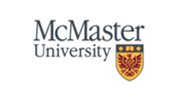 |
 |
INITIATE Research Study
Help Researchers Better Understand Fall Risk
The INITIATE Study aims to identify the best physical test for fall risk screening in older Canadians
 Who can participate in this research study?
Who can participate in this research study?
- English-speaking adults ages 65 and up, who live independently in the community
- Live in the Hamilton area or willing to come to McMaster Innovation Park @ 175 Longwood Road South, Hamilton
What does the study involve?
- 1 in-person study visit (2 hours), where we will test your mobility, balance, and strength
- 1 year of remote follow-up
- Answer questions about your health and your mobility over the phone
 Why should you participate?
Why should you participate?
- Receive a personalized report and learn about your mobility
- Receive up to $30 in gift cards of your choice for participating
To find more about the study go to www.theinitiatestudy.com. Call us at 905-525-9140, ext. 23203 or email initiate@mcmaster.ca.
Meet the Lead Researcher:
Dr. Marla Beauchamp is a Physiotherapist and Associate Professor in the School of Rehabilitation Science at McMaster University. The goal of her research is to keep older adults healthy and mobile in their communities for as long as possible.
HIFST Research Study
Have you had an injury from slip, trip, or fall that has limited your mobility? Do you find you walk or take the stairs differently or less frequently than before?
If you are ≥ 55 and have had an activity-limiting injury from a slip, trip, or fall in the past 6 months, you may qualify to participate in a pilot research study investigating a home-based high intensity functional strength training (HIFST) exercise program.
Eligible participants receive a 12-week home-based HIFST exercise program or a 12-week home-based lower body stretching program; both will include videoconferencing meetings.
For more information or to volunteer for this research study please contact Ashley Morgan, morgaa2@mcmaster.ca.
(Ashley Morgan is a PhD student in the School of Rehabilitation Sciences at McMaster, working under the supervision of Dr. Julie Richardson.)
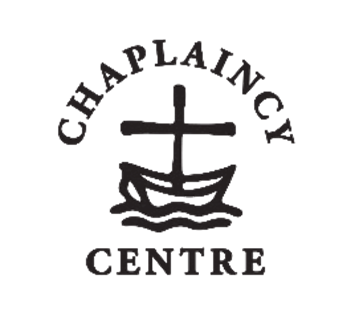 Exam Hospitality Program April 2023
Exam Hospitality Program April 2023
The McMaster Chaplaincy Centre is looking for volunteers to help with our Exam Hospitality Program. Every semester, the Chaplaincy Centre opens a drop-in space for students to receive free cookies and warm drinks to ease the stress of exams. We are looking for people who would like to chat with students, serve coffee, and help with cleanup. We are also looking for cookie donations (store bought or homemade - peanut free).
Last semester, we served over 750 students! The event is running this semester from April 14 to April 29. We hope to open the drop-in from 10am-8pm each day to cover the full range of exam times. However, we cannot do this without volunteers!
If you are interested in volunteering (particularly in the evenings) or have questions about the program, please contact Rev. Allison Barrett (our Interim Ecumenical Chaplain) at chaplain@mcmaster.ca or call 905-525-9140, x24207.
For more information about the Chaplaincy Centre, please visit mcmasterchaplaincy.org.
Become a Scenario Writer for a Mac Spinoff Company
Mac retirees are invited to participate in an academic/commercial enterprise by writing interview scenarios, called stations, designed to assess candidates' soft skills in public, private and academic sector professions. The company, ProspectHR MMI, is a spinoff from the University that markets a technique called the Multiple Mini Interview (MMI).
ProspectHR MMI is looking for station writers with diverse educational backgrounds and life experiences. Writers will be compensated $250 for each accepted scenario.
More detail is available in this article in the Fall 2022 MURAnews.
Please contact Jack Rosenfeld at jack.rosenfeld@prospecthrmmi.com if you are interested in participating in this endeavour. For more information, check https://www.prospecthrmmi.com/.
Members' Corner
The views and opinions expressed in Members’ Corner are those of the authors and do not necessarily reflect the official policy or position of MURA Council.
Pliny on the FIFA World Cup
A friend steeped in ancient history recently sent me an excerpt from Pliny the Younger (61 – 113 A.D.), who was dismayed by the madness and commotion of fans celebrating the Circensian games in Rome while he was quietly reading and writing in his study. “It does the more surprise me that so many thousand people should be possessed with the childish passion of desiring so often to see a parcel of horses gallop, and men standing upright in their chariots.” He continued by writing that it was not skill in horses or men that the crowd liked, “it is the dress that takes their fancy.” “Such mighty charms, such wondrous power reside in the colour of a paltry tunic.”
Horses and chariots aside, fans and players at the 2022 FIFA World Cup soccer tournament held recently in Qatar decked themselves out in every manner of costume in their team colours. Painted faces, overwhelming hats, banners, shirts, and streamers identified whole sections of the stadiums as partisans of Morocco, Portugal, Switzerland, or Spain. Netherlands fans, by day cheese or diamond merchants, transformed themselves into an orange, cheering amorphous mass. Goal keepers, those lengthy men, appeared in lilac silk, lime green shorts, or perhaps turquoise leggings, as they twisted themselves into pretzels to thwart oncoming balls kicked by men in checkered red shirts. Pliny had seen it millennia ago in Rome.
But what, I wondered, would Pliny think about the hairdos in Qatar? Hairdressers and barbers the world over have added adornments to soccer players - top knots, yellow pig tails, hirsute noggins, shiny shaved heads, sculpted scalps, and vermillion or green hair. With their scissors and razors and bleaching and colouring agents, they take heads of healthy hair and frost them with what appears to be fondant icing, much like my grandmother’s dark Christmas cake.In the tradition of parades, crowds, street demonstrations, and general mayhem, I propose that prior to the 2026 FIFA championship there be a midfield contest among barbers wielding razors. They have added to sport in ways Pliny could not imagine.
Singing!
I’d studied music in my teens and twenties – baritone horn/euphonium at Montreal West High School and trombone at le conservatoire in Montreal – but gave it all up to focus on science and ecology at McGill. Could I pick up the trombone again after 40+ years? Nah! But singing? You betcha!
Shortly before retiring (fall 2017), I’d mentioned my interest in learning to sing and joining a choir to a colleague. She thoughtfully and generously did some research on local voice teachers and gave me a gift certificate for two lessons from Jeremy Ludwig in east Hamilton. I was touched. She helped me take that most important step in adventure – the first.Ludwig and I hit it off and for three years I took private lessons with him, the last year and a half over Zoom because of, you know, the pandemic. I discovered I was a baritone and there was a genre of voice music called “Art Song.” I learned to sing songs in German (e.g., Bach’s Bist Du Bei Mir), French (e.g., Fauré’s Après un Rêve), and Italian (e.g., Handel’s Si, tra I chepi) as well as English. I memorized songs (good for the brain, right?) and sang solo with piano accompaniment in student recitals.
I gained confidence and my singing voice developed.
Was I ready to join a choir, my goal in learning to sing? Yes, but none were rehearsing or performing because of, you know, the pandemic. Finally, in mid-2022, choral groups were regrouping, and I saw an ad for auditions to the Bach-Elgar Choir (BEC), a fine classical choir with a long pedigree in Hamilton. Although I found the prospect daunting, my voice teacher encouraged me, and I figured “if I don’t try, I’ll always wonder if I could have made it or not.” To my surprise, the director liked my voice and invited me to join.But this story is not about the BEC. I tried it for four weeks and realized I was out of my depth. The choristers were supportive and friendly; the music was lovely but beyond my grasp, and I ended up more frustrated than fulfilled. The director was sympathetic, though, and I parted from the choir on good terms.
Now what?!
Hearing about my plight, a friend at church suggested I look into the Canadian Orpheus Male Choir (COMC), also a fine choral group with a long pedigree in Hamilton. Men only? That would be different, especially after working 23 years for an employer whose staff were +90% women. I knew of “The Men of the Deep” from Cape Breton and what a fine sound they made singing in four-part harmony. I decided to give the COMC a try.No audition this time; all they asked was that I enjoyed singing and could carry a tune. If I still liked them after three weeks, I’d be in. I joined the choir in late September and after one rehearsal I knew this was meant to be. Yes, the music selections were challenging but with some practice I knew I’d pick it up. My fellow baritones were great, and I quickly learned from them. I valued the social interaction, quite an asset for aging (as the Canadian Longitudinal Study on Aging folks had often repeated), and especially because of the social isolation I’d experienced from, you know, the pandemic.
The COMC’s repertoire includes popular songs, show tunes, ballads, jazz numbers, songs from musicals, opera choruses, folk songs, and hymns and other spiritual arrangements. Last month’s Christmas concert included Men Sing at Christmas (Three Christmas Songs), The Tyrolean Carol, Mary’s Boy Child, Betelehemu (in Nigerian), Light One Candle (by Peter Yarrow of Peter, Paul, and Mary fame), Shepherd’s Pipe Carol (John Rutter), O Holy Night, In Dulci Jubilo, and ended with a merry rendition of Christmas in Killarney sung together with The Steel City Rovers. The fall program included folk songs like Fogarty’s Bay and Make and Break Harbour (written and made famous by Stan Rogers), Bridge Over Troubled Waters, The Rose, and It’s a Long Way to Tipperary. The spring concert will feature songs from popular musicals (e.g., Les Mis) and a big-band medley.
The choir lost a few members over the past three years (because of, you know…) and needs to grow again. Its roster is now just under 30, and we would ideally add 10 new singers within the year. I invite all you male readers or male friends of readers to consider joining the COMC.
| Do you like to sing? Can you hold a tune? Would you like to meet a friendly and lively group of men who enjoy performing well-loved music, often at charity events, and to support community spirit? The ability to read music, although helpful, is not a must-have. Contact me (noel.fraser@mcmaster.ca) or Jim Lawton, the choir’s membership lead (905-333-4274; membership@comc.ca). Scroll through the website to learn more at https://comc.ca/. We rehearse at 7:30 p.m. for two hours every Tuesday evening at The Peoples Church, 240 Cumberland Ave. (corner of Sherman South). |
Remember, “Singing wonderfully right off the bat is not a prerequisite for us. We are always improving. It is surprising how good your sound becomes within a few months of singing regularly.”
A Notebook
When we moved to the corner of Balmoral and Hart Avenue in Burlington in 1974, my husband, Carl Riehm, a quiet man who taught mathematics at McMaster, was overtaken by a compelling interest. Stemming from a line of farmers, he noticed the lushness of nearby gardens and decided to have a garden of his own. At first, he tinkered with what was already in place when we moved in: a few roses, some sturdy thistles, and a hosta or two. But he had in mind growing rhododendrons, azaleas, lilies, hollies, dogwoods, and some unusual trees - a Japanese Umbrella Pine and a Cedar of Lebanon. As some of these were only marginally hardy, he began to search in the yard for any warm, sheltered, places to plant them - perhaps in the lee of the house or garage away from the prevailing west wind.
To locate such fortunate spots, he bought an indoor-outdoor, maximum-minimum thermometer along with a rain gauge. Being of a scientific turn of mind, he also bought a green cloth-bound universal diary in which to record daily temperatures. “June 21, 1977; 74, 58 bl. Garden Party” was his shorthand way of saying that our white Garden Party Rose, with its lovely undertones of yellow and pink, bloomed that June day when the high temperature was 74 and the low 58. Similarly, he proudly wrote of a favourite woodland plant, “June 26, 1978; 85, 65 bl. Mountain Laurel.”
It was not until 1980, however, that non-gardening observations crept into his notebook. The first of these, “August 24, 1980,” notes that he had seen a “Carolina Wren, warblers, and a Hermit Thrush” in the yard. He later recorded at different times the arrival in the garden of a badger, a coyote, a saw-whet owl, numerous raccoons, families of rabbits, and several days in succession, a “screech owl singing at 2:00 a.m.”Moving beyond wildlife, he recorded the visits of friends and mathematics colleagues, birthdays, weddings, and the births of six grandchildren. Every spring, he made note of our first bicycle trip and kept track of the distance we rode cycling to and from Toronto, in the Laurentians, or along the edge of Georgian Bay. While cycling into Hamilton one day, he stopped at Hamilton Cemetery to photograph the grave of Canadian mathematician John Charles Fields (1863 - 1932). He later recorded mathematical and social events at the Fields Institute for Research in the Mathematical Sciences in Toronto, which he regularly attended. On October 28, 2006, he noted tersely but possibly with satisfaction that he had finished the first draft of his book on finite groups.
Occasionally, election results and other non-personal events crept into his journal:
“October 31, 1984: 55, 37; Indira Ghandi killed”
“August 16, 1989: 75, 61; Full eclipse of moon, beautiful!”
“March 21, 1985: 35, 23; Bach’s 300th birthday”
“August 2, 1990: 83, 60; Iraq invades Kuwait”
“September 2, 1990: 82, 66; Stieb pitches no-hitter vs. Indians”
“October 30, 1995: 48, 37; NON ENCORE UNE FOIS”
“June 28, 2004: 69, 56; Lib. 135, Cons. 99, BQ 54, NDP 19, Ind. 1”
“March 18, 2014: 41, 24; Russia takes Crimea.”
Looking over the two volumes of Carl’s notebook, I see recurring patterns. Robins returned predictably every year in the third week of March; our Cedar of Lebanon crept upwards; December 31 parties at Maureen and Brian Bixley’s farm in Mulmur Township rang in many snowy New Years. There were wonderful summer days with friends at Lake Kawagama.
And then, death made its appearance. At first, it was the death of an uncle or aged neighbour; but then came the deaths of contemporaries, school friends, colleagues, cousins: Dennis Tieman; Barry Watson; Grant Scheifele; Timothy O’Meara; Bob and Shirley Piercy; Jim Woodford; Jim Stewart; Bob McNutt; and Ted Girodat. There are more.
The day before we moved from our corner house and garden in Burlington to an apartment in Dundas, he made his final entry. It is brief: “November 12, 2018: 41, 30.” I asked him if he might like a new maximum-minimum thermometer for our balcony overlooking Spencer Creek and its adjacent woods. His reply was short. “No thanks,” he said, turning a page.Carl too has died. But he leaves for his family a journal in his strong handwriting telling us what he found noteworthy daily for 41 years.

Courtesy of Meanwhile in Canada
|
MURAnews is produced by MURA members Denise Anderson (Production Editor), Helen Barton (News Editor), Nora Gaskin, John Horsman, and Marcia MacAulay. We welcome submissions from MURA members. Contributing writers: Cliff Andrews, Brian Beckberger, Dawnelle Hawes, Mary Johnston, and Kathy Overholt. |
© 2025 McMaster University Retirees Association | Having trouble with this site? Contact our Webmaster. |
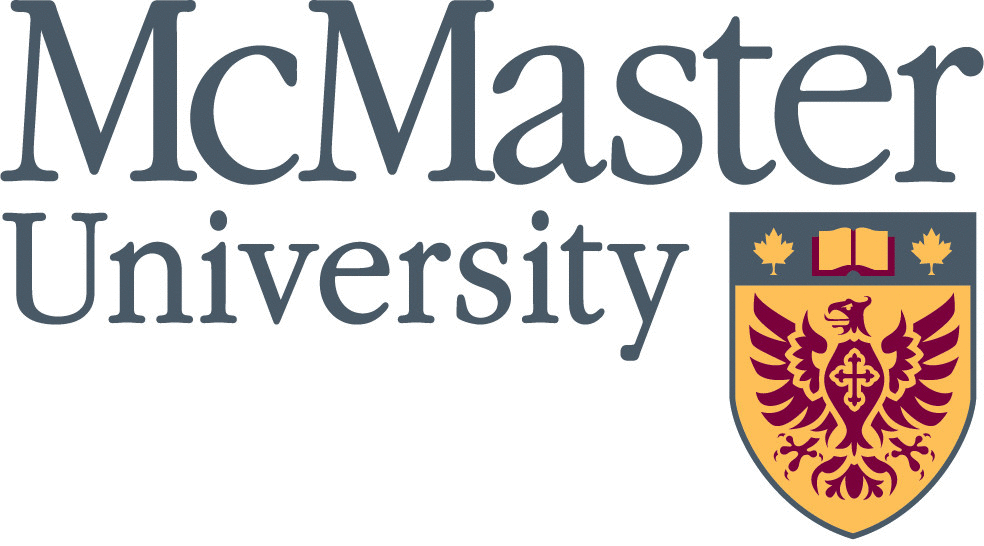
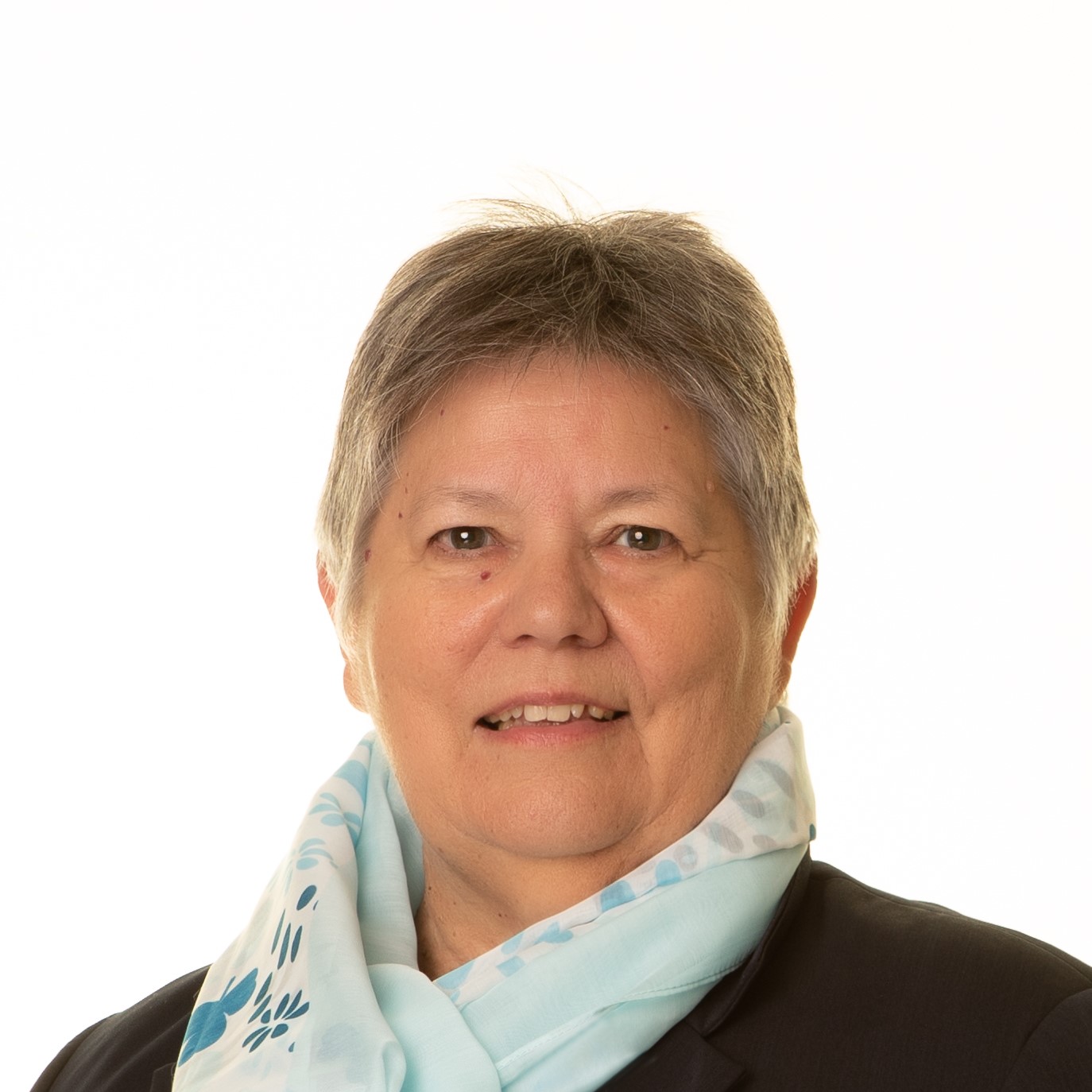

 In June 2022, I graduated from the Combined Honours Program in Health and Society & Aging and Society. I am proud to be working as a Research Assistant to Dr. Nicole Dalmer, Assistant Professor in the Department of Health, Aging and Society, whereby we explore the role of public libraries in bolstering social inclusion for community-dwelling older adults. Influenced by the immense love for my grandmothers, I have always been drawn to the field of Gerontology. Currently, I am applying to a Master of Science in Occupational Therapy in hopes to find my unique role to help ensure older adults receive holistic and quality care. Please accept my gratitude and thanks to the donors from MURA in having established this important student award.
In June 2022, I graduated from the Combined Honours Program in Health and Society & Aging and Society. I am proud to be working as a Research Assistant to Dr. Nicole Dalmer, Assistant Professor in the Department of Health, Aging and Society, whereby we explore the role of public libraries in bolstering social inclusion for community-dwelling older adults. Influenced by the immense love for my grandmothers, I have always been drawn to the field of Gerontology. Currently, I am applying to a Master of Science in Occupational Therapy in hopes to find my unique role to help ensure older adults receive holistic and quality care. Please accept my gratitude and thanks to the donors from MURA in having established this important student award.